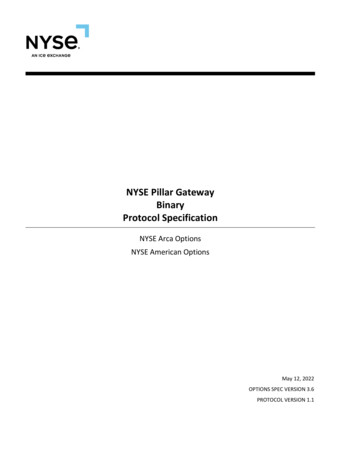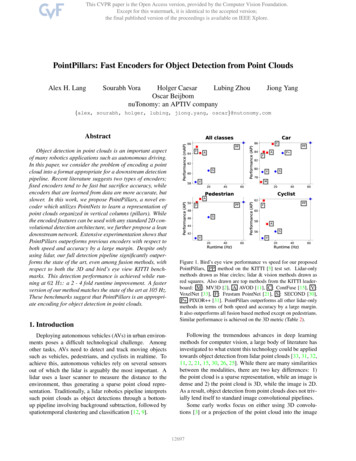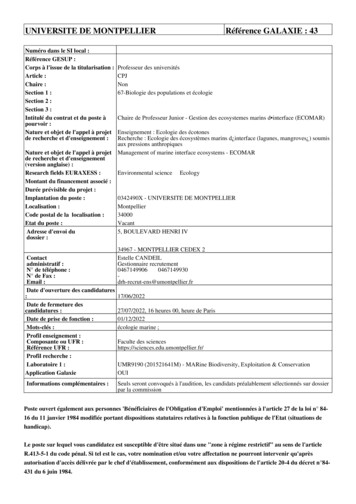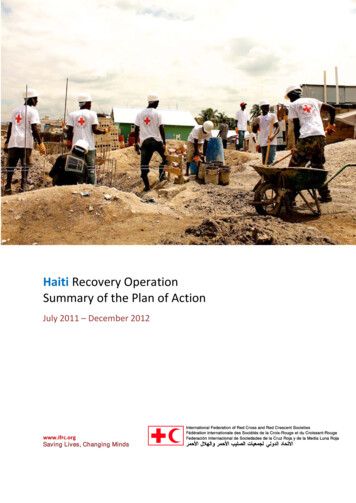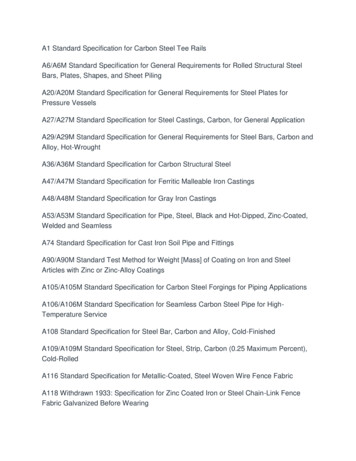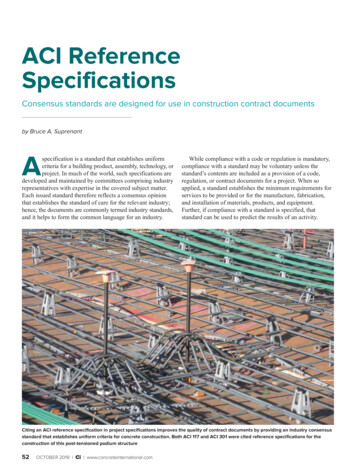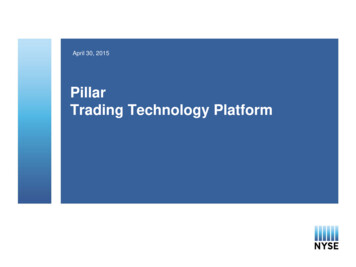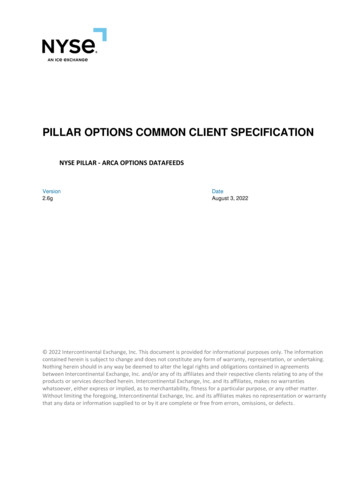
Transcription
PILLAR OPTIONS COMMON CLIENT SPECIFICATIONNYSE PILLAR - ARCA OPTIONS DATAFEEDSVersion2.6gDateAugust 3, 2022 2022 Intercontinental Exchange, Inc. This document is provided for informational purposes only. The informationcontained herein is subject to change and does not constitute any form of warranty, representation, or undertaking.Nothing herein should in any way be deemed to alter the legal rights and obligations contained in agreementsbetween Intercontinental Exchange, Inc. and/or any of its affiliates and their respective clients relating to any of theproducts or services described herein. Intercontinental Exchange, Inc. and its affiliates, makes no warrantieswhatsoever, either express or implied, as to merchantability, fitness for a particular purpose, or any other matter.Without limiting the foregoing, Intercontinental Exchange, Inc. and its affiliates makes no representation or warrantythat any data or information supplied to or by it are complete or free from errors, omissions, or defects .
PrefaceDOCUMENT HISTORYThe following table provides a description of recent changes to this document.VersionDateChange Description2.5Dec 1, 20202.6March 5, 20212.6aJune 2, 20212.6bJuly 27, 20212.6cAug 3, 20212.6dJan 11, 2022Updated verbiage and details around recovery method in section 5.1.7. UpdatedFTP location details for Pillar series mapping files2.6eJan 28, 2022Added examples for the Pillar Arca Options mapping files in Section 11.32.6fMar 21, 2022Updated logo for NYSE rebranding.Updated hyperlinks in Reference Section.Updated msgtype 3 - relabeled MPV and UOT as Reserved fields for Options.Updated section 10 - new filename for the Pillar Options Index Mapping file andadditional clarity on exact fields.2.6gAug 3, 2022Correction on MsgType 51 - Series status of ‘suspend’ is a valid status.Added outright series support for NYSE Arca and American OptionsRemoved section 5.1.7 Differences between Legacy RCF and Pillar RequestServer for equity as equity migration is completeAdded complex series support for NYSE Arca and American OptionsAdded PriceScaleCodeCabinet for Outright Series Index Mapping MessagesAdded options symbol mapping file sectionRemoved PriceScaleCode Cabinet for Outright Series Index MappingMessages and symbol mapping file.Corrected SecurityStatus ‘T’ to ‘B’Updated OptionSymbolRoot in Outright Series Index Mapping Message (Msg50) from 5 to 6 char, includes offset modification.Updated PutOrCall field definition from ASCII to Binary in Outright Series IndexMapping Message (Msg 50)Added clarification on PriceScaleCode for Complex Series to match any of theunderlying Outright Series (with a default value of ‘4’)Updated Complex Series Index Mapping message length from 80 to 109charactersAdded Request Server Denial of Service section to Pillar Request ServerUpdated Max number of Refresh Requests in a day from 5000 to 10000REFERENCE MATERIALThe following lists the associated documents, which either should be read in conjunction with this document or whichprovide other relevant information for the user: ICE Global Network connectivity documents IP AddressesCONTACT INFORMATIONService Desk Telephone: 1 212 896-2830 Email: support@nyse.com Data Sales: datasales@nyse.com 2022 Intercontinental Exchange, Inc.Pillar Options Common Client Specification v2.6g2
FURTHER INFORMATION For additional product information please visit NYSE Real Time Market Data. For updated bandwidth , visit the capacity page.CONTENTSPreface 2Document History . 2Reference Material . 2Contact Information . 2Further Information . 31.1.1Introduction . 5Receiving Real Time Market Data. 52.Packets and Heartbeats . 62.1Packet Header . 62.1.1Packet Header Structure . 62.2Heartbeats . 63.Message Field Content . 73.1Message Header . 73.1.1Msg Size Field . 73.2Date and Time Conventions . 83.3Sequence Numbers . 93.4Symbol Sequence Numbers and series sequence numbers . 93.5Prices . 93.6Order ID’s and Trade ID’s . 93.6.1Standard Pillar Correlation Rules . 93.6.1.1 Correlating ID fields in the market data with fields in the order entry API . 93.6.2NYSE Arca Options and NYSE American Options Migration to Pillar . 103.7Symbol and series Indexes . 104.4.14.24.34.44.54.64.74.8Messages Sent by the Publisher . 11Symbol Index Mapping Message (Msg Type 3) . 11Outright Series Index Mapping Message (Msg 50) . 13Complex Series Index Mapping Message (Msg 60) . 14Security Status Message (Msg Type 34) . 15Options Status Message (Msg Type 51) . 18Sequence Number Reset Message (Msg Type 1) . 19Source Time Reference Message (Msg Type 2) . 19Symbol Clear Message (Msg Type 32) . 205.Error Handling via the Pillar Request Server . 215.1Pillar request server . 215.1.1Request Processing . 215.1.1.1.1Handling Sequence Number Gaps . 215.1.1.2 Request Quotas . 225.1.2Request Server Denial of Service. 225.1.3Retransmission Format . 225.1.4Recovering from Client Late Starts or Intraday Failures . 225.1.5Refresh Message Format . 235.1.6Refreshing Symbol Information . 235.1.7Symbol Index Mapping Refresh Format . 236.6.1Pillar Request Server - Client Request Message . 25Retransmission Request Message (Msg Type 10). 257.Refresh and Retransmission - Client Response Messages . 267.1Refresh Header (Msg Type 35) . 267.1.1Shortened Refresh Header . 26 2022 Intercontinental Exchange, Inc.Pillar Options Common Client Specification v2.6g3
7.1.2Refresh Example . 267.1.3Header Fields in the Refresh Channels . 277.1.3.1 Refresh response to a request for all Symbol Index Mapping messages . 277.1.3.2 Refresh response to a request for a single Symbol Index Mapping message . 277.1.3.3 Refresh response to a request for a full refresh of all symbols . 277.1.3.4 Refresh response to a request for a full refresh of a single symbol . 277.2« Message Unavailable » Message (Msg Type 31) . 287.3Refresh Request Message (Msg Type 15) . 297.4Symbol Index Mapping Request Message (Msg Type 13) . 308.8.18.2Pillar Request Server - Response Messages . 31Request Response Message (Msg Type 11) . 31Heartbeat Response Message (Msg Type 12) . 329.Operational Information . 339.1System Behavior on Start and Restart . 339.2PILLAR Publisher Failover . 339.3Disaster Recovery Site. 339.4Proprietary DATA Production Hours (US Eastern Time) . 349.5NYSE PILLAR CERT Testing . 349.5.1Pillar Request Server Certification . 3410.Options Index Mapping File . 3510.1 Options Index Mapping File Format (PILLAR) . 3510.1.1 Underlying symbol mapping record format (MsgType 3) . 3510.1.2 Series mapping record format (MsgType 50) . 3610.1.3 Complex series mapping record format (MsgType 60) . 37 2022 Intercontinental Exchange, Inc.Pillar Options Common Client Specification v2.6g4
1.Introduction1.1 RECEIVING REAL TIME MARKET DATAReal-time PILLAR data is published in the form of messages with fixed length fields. All fields are binary except a verysmall number that are in ASCII format. For efficient use of the network, the messages are bundled into applicationpackets, and the packets are published via the multicast protocol.For capacity reasons, packets are routed over a number of predefined data sets called channels. Each channel isduplicated and published to two distinct multicast groups for redundancy. The two redundant multicast groups perchannel (called lines) are referred to as line A and line B. The union of the data in all channels that make up a product iscalled a feed.The IP addresses and port numbers of the production and test channels for each PILLAR feed can be found athttps://www.nyse.com/publicdocs/nyse/data/IP Addresses.xlsx. A client application receives a product by subscribing tosome or all of the channels that make up the feed.In response to requests for retransmission and refresh, market data is published by the exchange over dedicatedmulticast channels which correspond one-to-one with the real-time channels.See Error Handling and the Pillar Request Server for complete information. 2022 Intercontinental Exchange, Inc.Pillar Options Common Client Specification v2.6g5
2.Packets and Heartbeats2.1 PACKET HEADERAll packets sent on any PILLAR feed have an PILLAR Packet Header followed by one or more messages (with theexception of Heartbeat packets which do not contain any messages).The maximum length of a packet is 1400 bytes, so no message can be longer than 1400 – 16 bytes (max packet size the length of the Packet Header).2.1.1Packet Header StructureFIELD DESCRIPTIONBinaryThe size of the packet in bytes, including this 16-byte packet headerBinaryA flag that indicates whether this is an original,retransmitted, or ‘replayed’ message. Validvalues include: 1 – Heartbeat 10 – PILLAR Failover (see PILLARPublisher Failover) 11 – Original Message 12 – Sequence Number Reset Message 13 – Only one packet in retransmissionsequence 15 – Part of a retransmission sequence 17 – Only one packet in Refresh sequence 18 – Start of Refresh sequence 19 – Part of a Refresh sequence 20 – End of Refresh sequence 21 – Message UnavailableNumberMsgs31BinaryThe number of messages in this packetSeqNum44BinaryThe message sequence number of the firstmessage in this packetSendTime84BinaryThe time when this packet was published to themulticast channel, in seconds since Jan 1, 197000:00:00 UTC.SendTimeNS124BinaryThe nanosecond offset from the Send Time2.2 HEARTBEATSTo assist the client in confirming connection health, application heartbeats are sent once a minute by the RequestServer, and once a second by the real-time publishing servers (data, refresh and retransmissions channels).A heartbeat consists of a packet containing a Packet Header and no messages. The Packet Header’s Delivery Flag isset to 1 and Number Msgs is 0. Since a heartbeat packet contains no messages, a heartbeat does not increment thenext expected sequence number. See Sequence Numbers.Heartbeats sent by the Request Server must be acknowledged by the client. See Request Server. 2022 Intercontinental Exchange, Inc.Pillar Options Common Client Specification v2.6g6
3.Message Field ContentMessages are contiguous data structures consisting of fixed-length fields. No names or ‘tags’ appear in the message. Message fields align on 1 byte boundaries, so there are no filler fields for alignment purposes. Binary fields are published in Little-Endian ordering. Binary integer values are unsigned unless otherwise specified. All ASCII string fields are left aligned and null padded. Segmentation of messages across packets is not supported, so a message will never straddle a packet boundary. The length of a message as actually published may differ from the length of the message structure defined in theclient specifications. See Msg Size Field below for details.3.1 MESSAGE HEADERThe format of each message varies according to type, but each type starts with a standard 4-byte message header:FIELD DESCRIPTIONBinaryThe size of this message in bytesBinaryThe type of this messageMsg Size FieldIn order to handle future releases of PILLAR feeds smoothly, clients should never hard code msg sizes in feed handlers.Instead, the feed handler should use the Msg Size field to determine where the next message in a packet begins.This allows Support of PILLAR format variations among marketsClient flexibility when revised message structures go live in productionIn example 1 below, a message type is defined in the specification to have different lengths in different markets. Thetrailing field is not published in the Arca market. An Arca-coded client can process NYSE data correctly (but of coursecannot use the trailing Volume field without field-specific coding).Example 1: Message type with format variations across marketsFIELD NAMEOFFSETSIZEFORMATDESCRIPTIONMsg Size02BinarySize of the message.NYSE – 24 bytesNYSE American – 24 bytesLook at the MsgSize field to knowwhere the nextmessage starts.NYSE Arca - 20 bytesMsg Type22BinaryThe type of this message:998 – Example 1 msg 124BinaryPrice164BinaryVolume284BinaryNot published in Arca marketMarket-specificcontent 2022 Intercontinental Exchange, Inc.Pillar Options Common Client Specification v2.6g7
The variable message size can also insulate client code from future field additions that you may not need.In example 2, an existing message type is 16 bytes long.Example 2: Release NFIELD NAMEOFFSETSIZEFORMATDESCRIPTIONMsg Size02BinarySize of the message: 16 bytesMsg Type22BinaryThe type of this message:999 – Price message e124BinaryLook at the MsgSize field to knowwhere the nextmessage starts.In a future release, a four-byte volume field will be added, increasing the Msg Size to 20 bytes.If the client wishes to delay upgrading his feed handler for the new content, no coding is needed at the time of therelease. Proper coding of the MsgSize field up front allows the client to handle the unforeseen 20-byte format. On hisown schedule, the client can upgrade his feed handler to process the new field.Example 2: Release N 1: a new field is addedFIELD NAMEOFFSETSIZEFORMATDESCRIPTIONMsg Size02BinarySize of the message: 20 bytesMsg Type22BinaryThe type of this message:999 – Price message e124BinaryVolume164BinaryNew fieldLook at the MsgSize field to knowwhere the nextmessage starts.Unmodified clientscan handle longermessage structure(but can’t benefitfrom new content)3.2 DATE AND TIME CONVENTIONSDates and times are in UTC (Universal Time, Coordinated), and are expressed in nanoseconds since the Unix Epoch(Jan 1, 1970 00:00:00). A complete timestamp consists of two 4-byte fields: seconds since the Unix Epoch, andnanoseconds within the current second, as in a Unix timespec structure.The PILLAR Packet Header contains SendTime and SendTimeNS fields to show the time that the packet was publishedto the wire by the PILLAR Publisher.Most PILLAR messages additionally contain a timestamp called Source Time to show the time of the Matching Engineevent that caused the publication of this message.Many of the higher-volume PILLAR feeds such as Integrated and BBO explicitly publish only the nanoseconds portion ofthe Source Time in each message. The seconds portion is explicitly published in a Source Time Reference Message(Msg Type 2) once a second.Source Time Reference messages are published per Matching Engine partition (per TXN, which is equivalent tothe Integrated Feed channel number). 2022 Intercontinental Exchange, Inc.Pillar Options Common Client Specification v2.6g8
3.3 SEQUENCE NUMBERSEach message in a given channel is assigned a unique sequence number. Sequence numbers increase monotonicallyper channel, and can be used to detect publication gaps.To optimize publication efficiency, the sequence number is not explicitly published in each message. Instead, the PacketHeader contains the sequence number of the first message in the packet, along with the number of messages in thepacket. Using these fields, the client can easily associate the correct sequence number with each message.The sequence number combined with the channel ID form a message ID which is unique across the feed.3.4 SYMBOL SEQUENCE NUMBERS AND SERIES SEQUENCE NUMBERSIn addition to the sequence number, many message types explicitly include a field called Symbol Sequence Number(Series Sequence Number for Options), which identifies the message’s position in the sequence of all messagespublished by the feed for a given symbol.Clients who are tracking only a small number of symbols may opt to ignore sequence numbers and track only SymbolSequence Numbers (Series Sequence Number for Options) for each symbol or series of interest. If such a client everexperiences a Symbol Sequence Number (Series Sequence Number for Options) gap, he can request a refresh for thatsymbol or series.3.5 PRICESAll price fields are published as signed binary integers.To interpret a price correctly, the client must use the published price value as a numerator along with the Price ScaleCode in the symbol’s Symbol Index Mapping Message (Msg Type 3), Outright Series Index Mapping Message (MsgType 50) and Complex Series Index Mapping Message (Msg Type 60) as follows:Price Numerator10 PriceScaleCode3.6 ORDER ID’S AND TRADE ID’SThe Order ID and the Trade ID in order-based feeds such as Arca Options datafeeds are binary integers that uniquelyidentify an order or an execution. Order and Trade IDs are valid for the trading day only.3.6.1Standard Pillar Correlation RulesThese rules, which assume use of a Pillar matching engine and a Pillar Gateway, are applicable to the all Pillar Equityand Options markets.Order IDs are 8 bytes long and correlate uniquely across markets to the 8 byte OrderID in the gateway Order Ack.Trade IDs are 4 bytes long and correspond to the lowest 4 bytes of the 8-byte Deal ID in the gateway Execution Report.The Trade ID is unique per ME symbol partition (System ID in the Symbol Index Mapping message), and thereforeunique per symbol. Prepend 3 fields to the Trade ID as discussed below to make a unique match across markets to theDeal ID field in the gateway Execution Report.3.6.1.1 Correlating ID fields in the market data with fields in the order entry APIBy combining a 4-byte Order ID or Trade ID from an Integrated Feed message with the Market ID and System ID fromthe Symbol Mapping message as shown below, you can obtain the corresponding 8-byte ID from the gateway API.The table assumes the client byte ordering is Little Endian. If the client byte ordering is Big Endian, the byteorder is reversed.PILLARFIELD NAMESystem IDOFFSETSIZE (BYTES)FORMATDESCRIPTION01Binary011BinaryUnique ID for a single matching engineinstance (Pillar Symbol Partition or UTP 2022 Intercontinental Exchange, Inc.Pillar Options Common Client Specification v2.6g9
PILLARFIELD NAMEOFFSETSIZE (BYTES)FORMATDESCRIPTIONTU) found in the Symbol Index Mappingmessage’s System ID fieldMarket ID22BinaryID of the originating market in the SymbolIndex Mapping messageOrderID orTradeID44BinaryContents of 4-byte field beingdisambiguated3.6.2NYSE Arca Options and NYSE American Options Migration to PillarAs of this publication, NYSE American Options trade on legacy UTP matching engine technology. All order/quote entry isvia legacy CGW, MMD, and UGW gateways.NYSE American Options will migrate to Pillar on a published schedule with an underlying-based roll out.When Pillar Gateways are made available, they will support order/quote entry for series that have been migrated to Pillarand will not be made available in parallel for series traded on UTP. Similarly, legacy GWs will not support order/quoteentry for series trading on Pillar. The Standard Pillar correlation rules described in this document will only apply Seriestrading on Pillar and depend on the roll out schedule.3.7 SYMBOL AND SERIES INDEXESIn all PILLAR feeds, symbol-specific referential data is published in a Symbol Index Mapping Message (Msg Type 3),foroptions outright series-specific referential data is published in a Outright Series Index Mapping Message (Msg 50) andfor options complex series-specific referential data is published in a Complex Series Index Mapping Message (Msg 60) atsystem startup. Symbol and Series Index Mapping messages appear in each channel only for the symbols oroutright/complex series that appear in that channel.Any client who misses this initial spin can request a refresh of either Symbol or Outright Series Indexes by sending aSymbol Index Mapping Request Message (Msg Type 13)to the Request Server. The requested Symbol Index Mappingmessages and Outright Series Mapping messages will be re-published over the Refresh channels. See Common ClientSpec for info on the request server process.The Symbol and Series Index Mapping messages include the ASCII symbol in NYSE format along with a unique IDcalled a Symbol Index (Outright Series Index for outright, Complex Series Index for complex). Other symbol orseriesspecific messages such as Trade and BBO messages contain only the Symbol Index (Outright Series Index foroutright series, Complex Series Index for complex ) and no other referential data.Symbol and Series Indexes are the same for each symbol or outright/complex series every day and the same across allPillar-powered NYSE equity and option markets.If more than one Symbol and Series Index Mapping message is received for the same symbol within a trading day, thecorrespondence between the Symbol and the Symbol Index will not change, but other field values might. In this case,the latest field values override any earlier values, but do not apply retroactively. 2022 Intercontinental Exchange, Inc.Pillar Options Common Client Specification v2.6g10
4.Messages Sent by the Publisher4.1 SYMBOL INDEX MAPPING MESSAGE (MSG TYPE 3)This message is published over the real-time data channels at system startup or in the context of a refresh sequenceafter a Matching Engine or PILLAR Publisher failover. It provides referential data for a single specified symbol orunderlying symbol.FIELD NAMEOFFSETSIZEFORMATDESCRIPTIONMsg Size02BinarySize of the message: 44 bytesMsg Type22BinaryThe type of this message:3 – Symbol Index Mapping MessageSymbolIndex44BinaryThe unique ID of this symbol for all products withinthis market.Symbol811ASCIINull-terminated ASCII symbol in NYSE Symbology.Reserved191BinaryThis field is reserved for future useMarket ID202BinaryID of the Originating Market: 1 - NYSE Equities3 – NYSE Arca Equities4 – NYSE Arca Options8 – NYSE American Options9 - NYSE American Equities10 - NYSE National Equities11 - NYSE ChicagoSystem ID221BinaryID of the Originating matching engine server.Exchange Code231ASCIIFor listed equity markets, the market where thissymbol is listed:PriceScaleCode241Binary A – NYSE AmericanL - LTSEN – NYSEP – NYSE ArcaQ – NASDAQV - IEXZ – CBOE ‘ ’ -- (space or 0x20) for OTC or
2.6e Jan 28, 2022 Added examples for the Pillar Arca Options mapping files in Section 11.3 2.6f Mar 21, 2022 Updated logo for NYSE rebranding. Updated hyperlinks in Reference Section. Updated msgtype 3 - relabeled MPV and UOT as Reserved fields for Options. Updated section 10 - new filename for the Pillar Options Index Mapping file and
